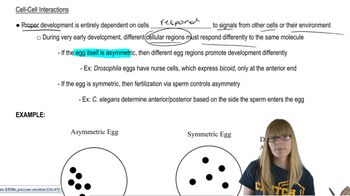Patterning of asymmetric eggs is first controlled through contact with sperm.
Table of contents
- 1. Introduction to Genetics51m
- 2. Mendel's Laws of Inheritance3h 37m
- 3. Extensions to Mendelian Inheritance2h 41m
- 4. Genetic Mapping and Linkage2h 28m
- 5. Genetics of Bacteria and Viruses1h 21m
- 6. Chromosomal Variation1h 48m
- 7. DNA and Chromosome Structure56m
- 8. DNA Replication1h 10m
- 9. Mitosis and Meiosis1h 34m
- 10. Transcription1h 0m
- 11. Translation58m
- 12. Gene Regulation in Prokaryotes1h 19m
- 13. Gene Regulation in Eukaryotes44m
- 14. Genetic Control of Development44m
- 15. Genomes and Genomics1h 50m
- 16. Transposable Elements47m
- 17. Mutation, Repair, and Recombination1h 6m
- 18. Molecular Genetic Tools19m
- 19. Cancer Genetics29m
- 20. Quantitative Genetics1h 26m
- 21. Population Genetics50m
- 22. Evolutionary Genetics29m
14. Genetic Control of Development
Early Developmental Steps
Problem 1a
Textbook Question
In the discussion, we have focused on large-scale as well as the inter- and intracellular events that take place during embryogenesis and the formation of adult structures. In particular, we discussed how the adult body plan is laid down by a cascade of gene expression, and the role of cell–cell communication in development. Based on your knowledge of these topics, answer several fundamental questions:
How have we discovered that specific genes control development in an organism like Drosophila?
 Verified step by step guidance
Verified step by step guidance1
Understand that the discovery of specific genes controlling development in Drosophila (fruit flies) was made possible through genetic screens, which involve inducing mutations and observing their effects on development.
Recognize that researchers used mutagenesis to create random mutations in the Drosophila genome and then screened for phenotypic changes in embryonic or adult structures.
Learn that the identification of mutants with developmental defects allowed scientists to pinpoint genes essential for specific developmental processes, such as segmentation or body patterning.
Understand that molecular techniques, such as cloning and sequencing, were used to identify and characterize the genes responsible for the observed phenotypes.
Appreciate that further experiments, such as in situ hybridization or reporter gene assays, were used to study the spatial and temporal expression patterns of these genes, revealing their roles in the gene expression cascade and cell–cell communication during development.
 Verified video answer for a similar problem:
Verified video answer for a similar problem:This video solution was recommended by our tutors as helpful for the problem above
Video duration:
2mPlay a video:
Was this helpful?
Key Concepts
Here are the essential concepts you must grasp in order to answer the question correctly.
Gene Expression in Development
Gene expression refers to the process by which specific genes are activated to produce their corresponding proteins, which play crucial roles in cellular functions and development. In embryogenesis, precise timing and regulation of gene expression are essential for the proper formation of tissues and organs, as different genes are turned on or off in response to developmental cues.
Recommended video:
Guided course

Penetrance and Expressivity
Drosophila as a Model Organism
Drosophila melanogaster, commonly known as the fruit fly, is a widely used model organism in genetics due to its short life cycle, well-mapped genome, and the ease of genetic manipulation. Studies in Drosophila have provided significant insights into the genetic control of development, allowing researchers to identify specific genes that regulate processes such as segmentation and body patterning.
Recommended video:
Guided course

Drosophila P Element
Cell-Cell Communication in Development
Cell-cell communication is vital during embryogenesis, as it allows cells to coordinate their activities and respond to signals from neighboring cells. This communication often involves signaling pathways that influence gene expression, guiding cells to differentiate into specific types and organize into functional structures, ultimately shaping the organism's body plan.
Recommended video:
Guided course

Cell-cell interactions

 3:46m
3:46mWatch next
Master Drosophilia Development with a bite sized video explanation from Kylia
Start learningRelated Videos
Related Practice
Multiple Choice
321
views
1
rank
